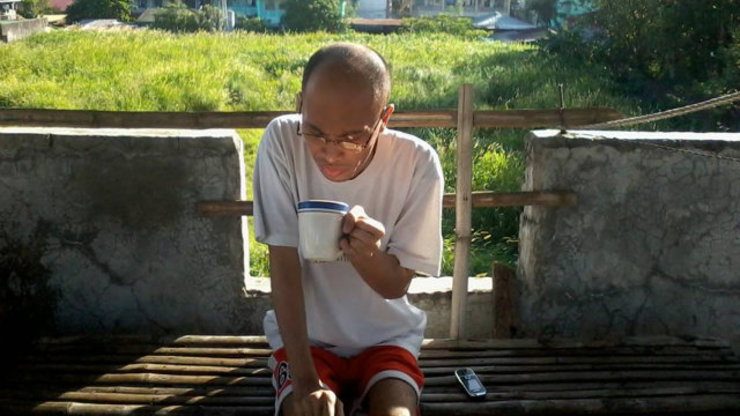SUMMARY
This is AI generated summarization, which may have errors. For context, always refer to the full article.
![[Dash of SAS] A lifeline running out](https://www.rappler.com/tachyon/r3-assets/612F469A6EA84F6BAE882D2B94A4B421/img/3A327F67E1C844408B0576F568BF6FBE/ana-santos-150.png)
He felt uneasy and thought it was strange, but he chose not to pay attention to it. The second alarm went off around March.
Yomi received only two weeks’ supply of ART. Later, he received only a week’s supply.
By then, panic was beginning to settle into the positive community or those living with HIV.
“I began to hear stories about others not getting any ARTs at all,” Yomi said. “People began talking about an ART shortage.“
A daily lifeline
Simply put, ARTs are a cocktail of medications which act as inhibitors – they inhibit the HIV virus from replicating inside the body and compromising the immune system.
Yomi and many others like him who are living with HIV have to take ARTs every day for the rest of their lives. It is what allows them to live normal, productive lives.
“It (shortage of ART) really is a life and death situation for us,” said Yomi.
Yomi is not exaggerating; he should know. Once, the line between life and death became very thin for him.
On his deathbed
It was 3 years ago when Yomi decided to change his lifestyle habits so he could be more healthy.
Ironically, shortly after, he became the sickest he had ever been in his life.
“I first started noticing that it was becoming more and more difficult for me to breathe. My colleagues began noticing lumps on my neck and facial area. They were my lymphnodes,” recalled Yomi.

At one point, he almost blacked out because he could no longer breathe and was rushed to the emergency room.
“The doctors said it was pneumonia, so I was being treated for that. But my body wasn’t responding [to the meds]. I wasn’t getting better.”
It would be another month before he was released from the hospital. And that was only because by then, the limit on his health card had run out.
Yomi was referred to an infectious diseases doctor who administered an HIV anti-body test.
In the month it took to get the test result, his health worsened. The pneumonia was compounded by oral candidiasis, a condition where the lining of the mouth is infected with fungus. It became painful for him to swallow food or drink water, and his weight dropped to about 70 pounds – half of his original weight. Yomi could no longer work and had to resign his job.
Then the results came: Yomi was positive for HIV.
His mother was silent when he told her the cause of his illness.
“Ang sinabi lang nya ay hinding-hindi n’ya matatanggap na mauna siya sa ‘kin.” (The only thing she told me was that she would not be able to accept it if I went before her.)
It was only through ART that he slowly began to get better. He got his strength back and gained back some weight. Currently, Yomi is the secretary of the Project Red Ribbon, a support group for people living with HIV.
“I was a case of late diagnosis. I could have died.”
Shortage
“We have received reports of ART stock outs thrice since late last year,” said Jonas Bagas, executive director of The Library Foundation (TLF), a pioneering community-based advocacy group on HIV / AIDS.
According to HIV advocacy groups and NGOs, the first instance was in December, then in March and, more recently, last September.
Some reasons were reportedly administrative in nature; delays in the processing of requisition orders for new stock necessitated the approval of a new budget needed to reflect foreign currency fluctuations.
Some were due to improper forecasting on quantity required and others were allegedly due to the delayed compliance by the Department of Health (DOH) with procedures at the Bureau of Customs such as the submission of an import entry permit.
“Any kind of product that comes into the country will require an import entry permit. During the last stock out in September, the DOH was late in submitting these documents, prompting the BOC to hold on to the stock,” explained Bagas.

“Many of us had to keep going back to the treatment hub, which is far. You really have to devote one whole day just to get your meds,” said Ranier Naldoza, who has been living with HIV for about 7 years now. (Read: Young people are dying when they shouldn’t be)
ART is released only through specialized treatment hubs that also administer the blood testing and other procedures required for the care and management of HIV. The medicines can only be sourced through the government.
In Metro Manila, there are 4 treatment hubs where PLHIV can get ARVs: Research Institute for Tropical Medicine (RITM) in Muntinlupa City, San Lazaro and Philippine General Hospital (PGH) in Manila, the Makati Med, and Medical City in Pasig City.
As a recipient country under the Global Fund, Philippines have its ARTs subsidized under a 50-50 arrangement. Currently, the DOH estimates that there are more than 7,172 people living with HIV who are on ART.
“We need to plan and forecast better to make sure that ART stock outs don’t happen again,” stressed Bagas. “The first step is for the government to acknowle that there is a problem in our ARV supply chain, and reforms should be instituted.”
Shortage, not a stock out
“Stock [of ART] was running low, but it did not come to a point where we had no stocks at all,” said Dr Genesis Samonte, chief of the HIV Surveillance Unit of the National Epidemiology Center of the Department of Health (DOH-NEC).
Samonte explained the procurement of ARTs as a “complex process” that requires a delicate balance of pricing, forecasting, and coordination among the DOH and treatment hub pharmacies where the medication is released, and monitoring of medication shelf life.
“It takes about 6 months to one year to procure ARTs. But the shelf life of ARTs is only 2 years. We cannot over order and procure more.”
Most other medications have a shelf life of about 3 years.
“We are working on improving our forecasting, but this is a moving target. People who go on ART will be on ART for life and the number who will need it is based on the many other factors like how many will even get tested,” Samonte explained.
The increasing number of people in the Philippines living with HIV further compounds the problem. Since 2007, there has been a 587% increase in new HIV cases in the Philippines. (READ: HIV crisis worsening in the Philippines)
The Philippine HIV Registry shows that there were 3,399 newly reported HIV cases from January to July 2014. In 2000, there was one new case of HIV every 3 days. In 2012, that number increased to one new case of HIV every two hours.
“We acknowledge that the current procurement and supply chain needs to be improved. We at the DOH are committed to find ways to address that problem,” said Samonte – Rappler.com
Ana P. Santos writes about sex and gender issues. Seriously. She is a regular contributor for Rappler apart for her DASH of SAS column, which is a spin off of her website, www.SexAndSensibilities.com (SAS). Follow her on Twitter at @iamAnaSantos.
Add a comment
How does this make you feel?
There are no comments yet. Add your comment to start the conversation.